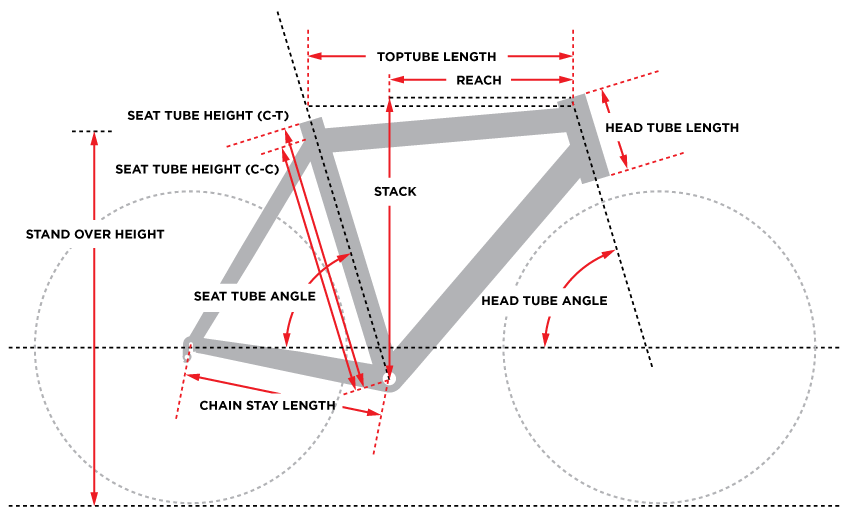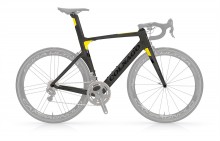 Loading... Please wait...
Loading... Please wait...Categories
Popular Brands
Our Newsletter
COLNAGO Concept Disc Frameset
Product Description
CONCEPT DISC FRAMESET SPECIFICATIONS
- Bottom Bracket Type Threadfit82.5 - BB86 Required
- Frame Material High Modulus Carbon
- Fork Colnago Concept Carbon, 1 1/4"-1 1/8"
- Headset Colnago Integrated, 1/8" to 1 1/4"
- Seatpost Colnago Concept Aero Carbon
- Front Derailleur Type Braze-On Required
CONCEPT DISC FRAMESET GEOMETRY / SIZE CHART

| Size | Seat Tube (c-c) | Seat Tube (c-t) | Top Tube Length | Head Tube Length | Chain Stay Length | Seat Tube Angle | Head Tube Angle | Stand Over Height | Wheel Size | Stack | Reach |
|---|---|---|---|---|---|---|---|---|---|---|---|
| 48 | 480 | 520 | 527 | 127 | 404 | 74.6 | 71.5 | - | 700c | 525 | 382 |
| 52 | 520 | 560 | 550 | 163 | 407 | 73.6 | 71.9 | - | 700c | 561 | 384 |
CONCEPT DISC FRAMESET INFORMATION
The Concept Disc Brake Frameset from Colnago is more than an idea; it’s the execution of several great ideas in one place. They started with Colnago’s legendary ride, built an aero bike around those angles, and then adjusted the carbon layup to support rotor disc brakes. It’s a sight to behold, and one you’re going to need to hang on to as it goes like few bikes once you put power to the pedals.
Aero bikes and sweet-riding bikes are often in separate categories. Colnago wanted to marry the two. This is in many respects Concept 2.1, as the project began with the V1-R, and evolved into the Concept Rim Brake Frameset, then this. It’s a UCI-approved aero road frame. Everything about the monocoque design has been looked at through the lens of aerodynamics—while still being a Colnago. The Concept is more aero than Colnago’s V1-R by the same amount that the V1-R was more aero than the Colnago C60. The result is a bike that is more aerodynamic than any previous Colnago, stiffer than any previous Colnago, but still a bike that is comfortable enough to race or ride for eight hours at a time.
In terms of geometry, this is the same traditional race geometry you’ll find on the V1-R and the C64. It’s designed to be fast without taking much attention to pilot in a straight line. Responsive without twitchy. You’ll find a taller head tube on Colnagos relative to many other pro bikes. This is because in the real world, it’s better to have your stem with fewer spacers underneath it.
When discussing aerodynamics, the fork hits the wind first. So Colnago worked on this first. The legs utilize a NACA airfoil shape, but the specific aspect is designed to work with bike racing and riding speeds. Three essential parts of the design are the leg stance, the crown, and how the crown mates with the frame. The legs are wide both for better aerodynamics and to fit tires up to 28mm wide. The crown has been designed as the trailing edge for integrated direct-mount rim brakes. And the backside of the crown and the head/down tube frame junction has been designed so the crown fits in a notch to further smooth out airflow.
The head tube has been shaped for aerodynamics as well, with no round leading edge. Colnago utilizes a tapered steerer here, but the taper is a more traditional 1 1/8” upper and 1 ¼” lower for ideal ride quality. The included headset is new and proprietary to Colnago. They call it the Colnago Concept. Much like their other headset design, this one relies on removable cups. What’s new is that the cups are made of a carbon composite and nylon and elastomer. These cups are vertically channeled as well so there are numerous ways for the headset to damp vibration coming up the fork.
The downtube’s shape changes as it goes from the head tube to the bottom bracket. The aspect ratio is tuned for cycling speeds and to shroud the water bottle(s) from the wind. The tube is relatively wide to begin with and gets wider by the bottle cage mounts. You’ll notice three mounts there. Use the lower two for better aero when running one bottle, the upper two when mounting a seat tube bottle cage.
The seat tube is shaped for aerodynamics, but in two segments. The segment below the dropped seat stays shrouds the rear wheel—it fits tires up to 28mm wide, but is designed around ideal aerodynamics at 25mm wide. The segment above the stays smoothes airflow. The seat tube cluster itself is something Colnago is proud of. The shape and layup of each size frame’s cluster is different to optimize both aerodynamics and ride quality.
The frame comes with a proprietary seat post that features 15mm of setback. There’s an accessory post if you want more or less. The post secures via a hidden wedge, adjusted from the top tube. Both the post and the wedge are finished with a grit treatment, which increases surface friction to eliminate any chance of slippage.
There’s less deflection at the head tube and bottom bracket than the V1-R, which is great for sprinting and manhandling the bike out of the saddle. The Concept, though, has greater rear triangle deflection than the V1-R, and less than the C60, which is proof that the bike still has comfort designed in. Even with all the extra material to maximize aerodynamics, frame weight is still only around 1500g for the frame and fork.
Colnago has also designed a carbon aero stem and handlebar to go with the Concept. Purchased separately, you can go with just the stem, or just the bar or both.
Braking is via rotor discs and calipers. This necessitated two changes. One is thru-axles, which are 100x12mm in front and 142x12mm in back. The second is more material to resist the greater forces that the calipers put on the frame. That means each frame is about 100-150g heavier than it’s rim-brake brother, The caliper fixing method is flat mount, which is set up for 140 and 160mm rotors.
In terms of the bottom bracket, Colnago still employs their ThreadFit 82.5, which is like BB86, only the races/cups are made of aluminum and can be replaced. The cable routing is internal. You can run mechanical or electronic—with Di2, the battery goes in the seat post, EPS the seat tube, SRAM on the derailleurs. The bike comes with the necessary plates and stops to make all of these mesh perfectly with your frame.
Find Similar Products by Category
Customers Who Viewed This Product Also Viewed
-
$1,787.50

-
$2,527.25

-
$1,814.45

-
$8,249.45

Add to Wish List
You Recently Viewed...
Information |
My Account |
Connect With UsSecure Payment
|
GET THE APPSentosa Bicycle App is now available on Google Play & App Store.
|










